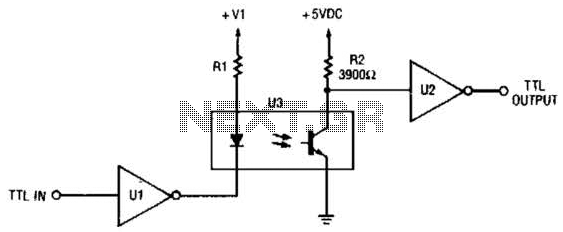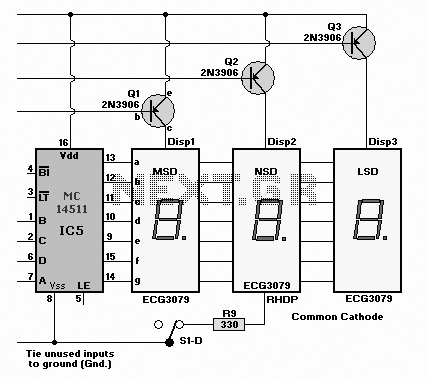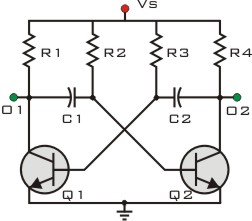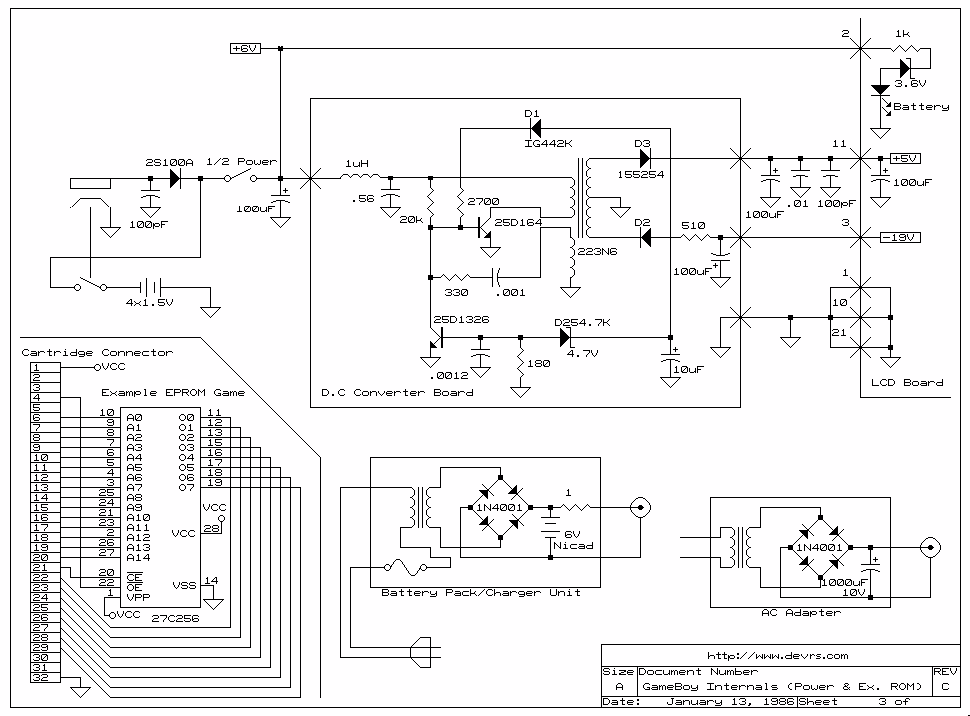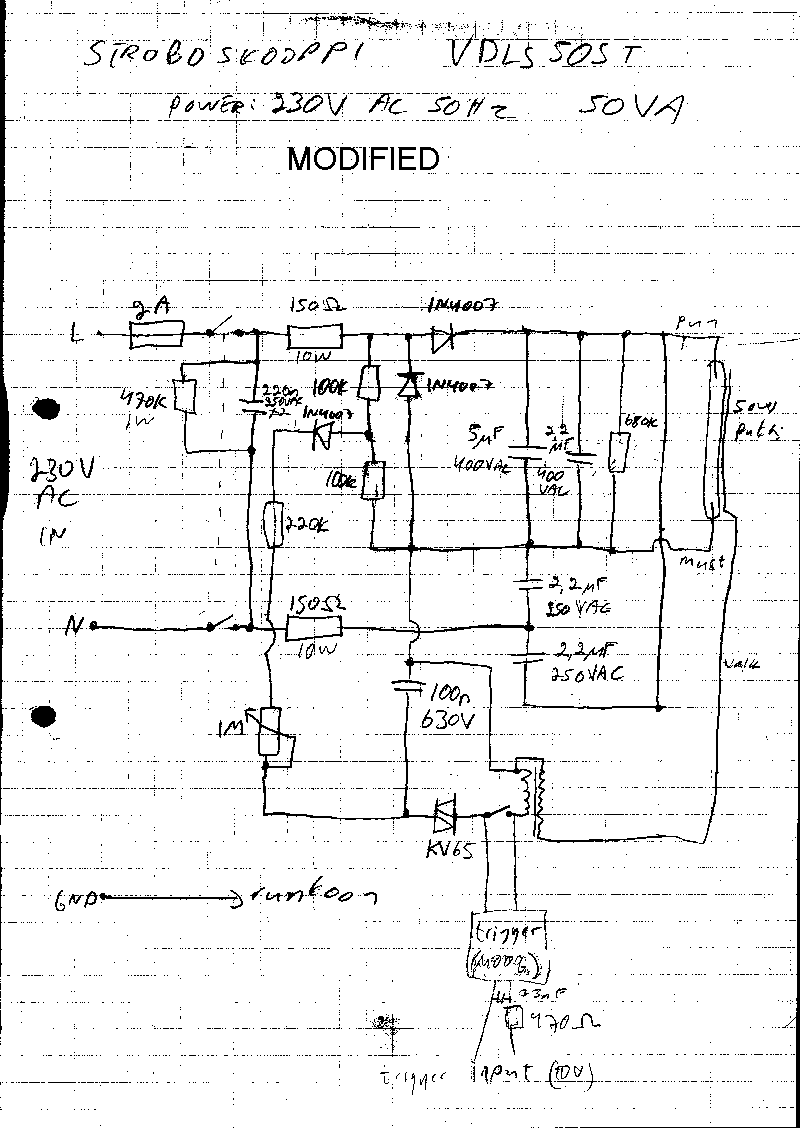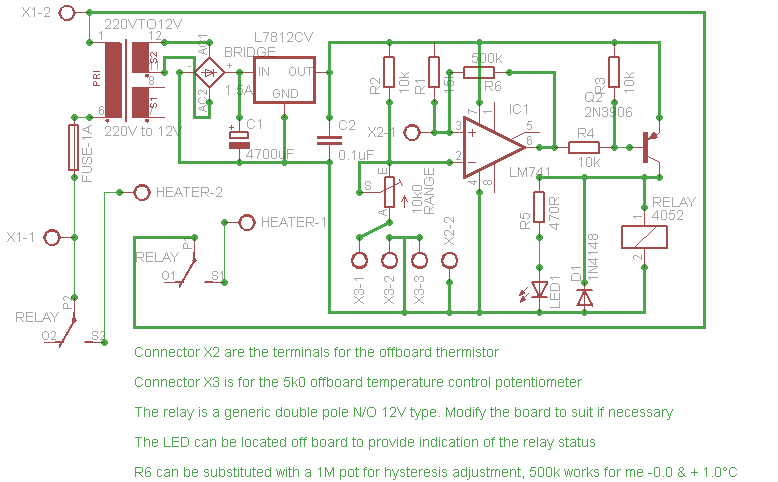
Solid State Circuits 2
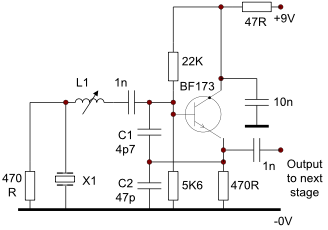
This circuit operates effectively from low frequencies up to at least 120 MHz using series resonant crystals in their fundamental or overtone mode. The output can be obtained from the feedback tap, a low impedance winding on L2, or from the drain of the J310 through a low-value capacitor. A buffer stage should follow to isolate subsequent stages from the oscillator. The combined series capacitance of C1 and C2 resonates with inductor L1 at the desired frequency, and crystal X1 must exhibit a fundamental or overtone series resonance at the same frequency. C2 is typically about five times the value of C1. Inductor L2 is generally necessary at frequencies above approximately 60 MHz and should be selected to resonate with the total parallel capacitance of X1 at the oscillation frequency. If the circuit exhibits signs of free-running oscillation controlled by L1, then L2 will be required. The parallel capacitance of X1 usually falls within the range of 4 pF. This circuit is mainly designed for operation as an overtone oscillator, functioning effectively from 20 MHz to 120 MHz depending on the crystal and active device used. Its operation is highly stable, although the output level is relatively low. The combination of L1, C1/C2, and the input capacitance of the transistor forms a quarter-wave network, converting the low impedance series resonance of the crystal into a high impedance parallel resonance at the transistor's base. Depending on the internal base/emitter capacitance, C1 may not be necessary at higher frequencies. This circuit represents a Colpitts fundamental mode parallel resonant oscillator for crystals intended for a 30 pF load capacitance. The specified values are suitable for frequencies between 8 MHz and 12 MHz and will need adjustment for significantly different frequencies. Transistors TR1 and TR2 should be characterized for the desired frequency range. Devices such as the BC108 have been shown to perform in this circuit, although they are not specified for high frequencies. Preferred devices include BF115 and BF199. The RF output is not sinusoidal. A 470-ohm resistor across the crystal suppresses oscillation at the parallel resonant frequency and must not be omitted. Most RF-characterized transistors will function in this circuit. This fundamental mode Pierce oscillator can be utilized across a wide frequency range with minimal or no changes to component values. The circuit was initially developed in the 1970s using a 2N5245 RF JFET, which has become difficult to obtain; a J310 has been substituted, featuring an Idss range of 24. Although the higher value drain resistor enhances gain at lower frequencies, it results in a noticeable reduction in output level at higher frequencies due to the RC time constant affecting circuit gain and slew rate. As is common with oscillators, the output power level is low. If distribution to multiple circuits is necessary, an emitter follower or equivalent buffer stage should be included. A bipolar NPN emitter follower may be DC coupled to the FET drain through a 47-ohm resistor to mitigate any potential oscillation at VHF. If opting to replace the drain resistor with an RF choke, the emitter follower should not be DC coupled to the drain, as the drain voltage may exceed the supply line during positive half cycles.
This oscillator circuit is designed to utilize a crystal for frequency stabilization, enabling precise frequency generation suitable for various RF applications. The configuration employs a Colpitts oscillator topology, which is known for its stability and simplicity. The circuit's performance is contingent on careful selection of components, particularly the resonant inductor and capacitors, which must be matched to the intended frequency of operation. The use of a buffer stage is critical in maintaining signal integrity, especially in applications where the oscillator output needs to drive multiple loads or stages.
In practice, the choice of transistors is also essential, as their frequency response characteristics can significantly influence the overall performance of the oscillator. The output waveform's non-sinusoidal nature may necessitate additional filtering or shaping if a clean sine wave is required for subsequent stages. The incorporation of a resistor across the crystal serves a dual purpose: it stabilizes the oscillation frequency and prevents unwanted resonances that could lead to circuit instability.
Overall, this circuit exemplifies a robust solution for generating RF signals across a wide frequency range, with careful attention to component selection and circuit layout ensuring optimal performance in practical applications.This circuit can be used from low frequencies to at least 120MHz using series resonant crystals on their fundamental or overtone mode. The output can be taken from the feedback tap as shown, a low impedance winding on L2 or from the drain of the J310 via a low value capacitor.
The following stage should be used a a buffer to isolate subsequent sta ges from the oscillator. The combined series value of C1 and C2 resonates with inductor L1 at the desired frequency and crystal X1 must have a fundamental or overtone series resonance as appropriate at the same frequency. C2 is about five times the value of C1 Inductor L2 is generally only required at frequencies above about 60MHz and must be chosen to resonate with the total parallel capacitance of X1 at the frequency of oscillation.
If the circuit shows signs of free running oscillation controlled by L1 then L2 will be required. The parallel capacitance of X1 will typically be 4 - This circuit is primarily intended for use as an overtone oscillator and will work from 20MHz to 120Mhz depending on the crystal and active device. Operation is extremely stable but the output level is fairly low - pk. L1, C1/C2 and the input capacitance of the transistor act as a quarter wave network, converting the low impedance series resonance of the crystal into a high impedance parallel resonance at the base of the transistor.
C1 may not be needed at higher frequencies depending on the internal base/emitter capacitance. This circuit is a Colpitts fundamental mode parallel resonant oscillator for crystals designed for use with a 30pF load capacitance. Values shown are suitable for 8 - 12Mhz and will require changing for significantly different frequencies.
Transistors TR1 and TR2 should be characterised for the required frequency range. Devices like the BC108 have been shown to work in this circuit but are not specified at high frequencies. Preferred devices would be BF115, BF199 etc. The RF output is not sinusoidal. The 470R resistor across the crystal suppresses oscillation at the parallel resonant frequency and must not be omitted.
Most RF characterised transistors will work in this circuit. This fundamental mode Pierce oscillator can be used over a wide frequency range with little or no changes to component values. The circuit to the right was originally developed by myself in the 1970s using a 2N5245 RF JFET which had a relatively low Idss range but they are now very difficult to obtain.
A J310 has been used instead which has an Idss range of 24 - Although the higher value drain resistor gives more gain at the low frequencies, there is an obvious reduction in output level at the higher frequency end due to the RC time constant impacting on circuit gain and slew rate. As with most oscillators the output power level is low. If it needs to be distributed around a number of circuits then an emitter follower or equivalent buffer stage should be included.
A bipolar npn emitter follower may be DC coupled to the FET drain via a 47ohm resistor to suppress any tendency to oscillate at VHF. If you decide to replace the drain resistor with an RF choke then the emitter follower should not be DC coupled to the drain as the drain voltage will exceed the supply line on positive half cycles.
🔗 External reference
This oscillator circuit is designed to utilize a crystal for frequency stabilization, enabling precise frequency generation suitable for various RF applications. The configuration employs a Colpitts oscillator topology, which is known for its stability and simplicity. The circuit's performance is contingent on careful selection of components, particularly the resonant inductor and capacitors, which must be matched to the intended frequency of operation. The use of a buffer stage is critical in maintaining signal integrity, especially in applications where the oscillator output needs to drive multiple loads or stages.
In practice, the choice of transistors is also essential, as their frequency response characteristics can significantly influence the overall performance of the oscillator. The output waveform's non-sinusoidal nature may necessitate additional filtering or shaping if a clean sine wave is required for subsequent stages. The incorporation of a resistor across the crystal serves a dual purpose: it stabilizes the oscillation frequency and prevents unwanted resonances that could lead to circuit instability.
Overall, this circuit exemplifies a robust solution for generating RF signals across a wide frequency range, with careful attention to component selection and circuit layout ensuring optimal performance in practical applications.This circuit can be used from low frequencies to at least 120MHz using series resonant crystals on their fundamental or overtone mode. The output can be taken from the feedback tap as shown, a low impedance winding on L2 or from the drain of the J310 via a low value capacitor.
The following stage should be used a a buffer to isolate subsequent sta ges from the oscillator. The combined series value of C1 and C2 resonates with inductor L1 at the desired frequency and crystal X1 must have a fundamental or overtone series resonance as appropriate at the same frequency. C2 is about five times the value of C1 Inductor L2 is generally only required at frequencies above about 60MHz and must be chosen to resonate with the total parallel capacitance of X1 at the frequency of oscillation.
If the circuit shows signs of free running oscillation controlled by L1 then L2 will be required. The parallel capacitance of X1 will typically be 4 - This circuit is primarily intended for use as an overtone oscillator and will work from 20MHz to 120Mhz depending on the crystal and active device. Operation is extremely stable but the output level is fairly low - pk. L1, C1/C2 and the input capacitance of the transistor act as a quarter wave network, converting the low impedance series resonance of the crystal into a high impedance parallel resonance at the base of the transistor.
C1 may not be needed at higher frequencies depending on the internal base/emitter capacitance. This circuit is a Colpitts fundamental mode parallel resonant oscillator for crystals designed for use with a 30pF load capacitance. Values shown are suitable for 8 - 12Mhz and will require changing for significantly different frequencies.
Transistors TR1 and TR2 should be characterised for the required frequency range. Devices like the BC108 have been shown to work in this circuit but are not specified at high frequencies. Preferred devices would be BF115, BF199 etc. The RF output is not sinusoidal. The 470R resistor across the crystal suppresses oscillation at the parallel resonant frequency and must not be omitted.
Most RF characterised transistors will work in this circuit. This fundamental mode Pierce oscillator can be used over a wide frequency range with little or no changes to component values. The circuit to the right was originally developed by myself in the 1970s using a 2N5245 RF JFET which had a relatively low Idss range but they are now very difficult to obtain.
A J310 has been used instead which has an Idss range of 24 - Although the higher value drain resistor gives more gain at the low frequencies, there is an obvious reduction in output level at the higher frequency end due to the RC time constant impacting on circuit gain and slew rate. As with most oscillators the output power level is low. If it needs to be distributed around a number of circuits then an emitter follower or equivalent buffer stage should be included.
A bipolar npn emitter follower may be DC coupled to the FET drain via a 47ohm resistor to suppress any tendency to oscillate at VHF. If you decide to replace the drain resistor with an RF choke then the emitter follower should not be DC coupled to the drain as the drain voltage will exceed the supply line on positive half cycles.
🔗 External reference
